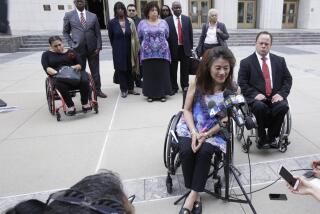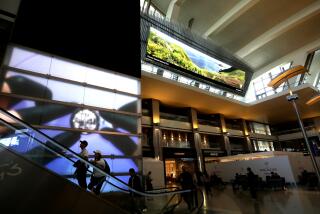Airport Faulted on Access for Handicapped
SANTA ANA — The new terminal at John Wayne Airport is in violation of several state codes designed to make public facilities accessible to the handicapped, a state consultant said Thursday after taking a four-hour tour of the $63-million project.
Among the apparent violations cited were water fountains and coin slots in pay telephones that are too high, mirrors, towel and soap dispensers in restrooms that exceed height limitations, and pay phones without amplifiers to aid the hearing-impaired.
In addition, Ronald D. Mincer, a consultant to the state Department of Rehabilitation, said that both the departing and arriving areas lack the required curb-cuts, or wheelchair ramps, at entrances and pathways and that some of the existing curbcuts are not wide enough.
“There are several areas that are not to code and should be corrected as soon as possible,” said Mincer, who was accompanied by several representatives of organizations for the disabled. Mincer, himself a quadriplegic, is a member of the Community Access Network which advises the state on handicapped accessibility.
Although none of the violations are serious enough to delay Sunday’s grand opening, they will have to be corrected or the county will risk losing operating permits for the new terminal, according to Chuck Fleming, chief of the community-access division of the state Department of Rehabilitation.
County officials expressed surprise at Mincer’s findings and said the possible violations could be the result of conflicting interpretations of the codes. Nonetheless, officials said they would correct any problems.
Mincer said he would submit a list of alleged violations to airport managers, the County Board of Supervisors and the Department of Rehabilitation.
Also touring the building on Wednesday was Brenda Primo, executive director of the Dayle McIntosh Center for the disabled in Anaheim. She said that her group will offer assistance to the county in correcting deficiencies.
Primo stressed that the group found few complaints with the overall design of the building.
“There has to be an element of universal design, and when you are trying to please as many people as possible, you are not going to please everyone,” she conceded. “But there are a few things that will have to be fixed.”
Airport officials said the facility, which has been years in the making, was designed to adhere to all state-accessibility requirements.
“To our knowledge, the entire building is in full compliance with both the letter and intent of (state) codes,” said Philip L. Kroeze, executive vice president of Leason Pomeroy Associates, the lead architects for the terminal.
However, Kroeze acknowledged that “some things may not have been constructed as designed.”
Paul Peters, terminal project manager, noted that county building officials had approved all designs and issued required permits.
“The Environmental Management Agency would never allow state codes to be violated,” said Peters, who toured the airport with Mincer. “I think it’s an interpretation of codes we are bumping up against here.”
William Eckles, chief of building inspection for the county, insisted that inspectors would not have approved items that did not meet state requirements. However, Eckles conceded that some features may have been overlooked during construction and that some state codes may have been interpreted incorrectly.
“I would think that any (violations) should have been caught,” he said. “But if we find things that aren’t in compliance in the handicapped area or any other area, those things will be modified.
“These thing are not going to get swept under the rug.”
Supervisor Thomas F. Riley, for whom the new terminal is named, said the alleged violations are “an absolute concern of mine” and vowed to ensure that the county will meet all accessibility codes.
“I have always indicated a strong interest in the handicapped, and I am sure we will be up to code,” he said.
All of the alleged violations fall under Title 24 of the California Building Code, which lists specific requirements to accommodate individuals with visual and hearing impairments and those confined to wheelchairs.
State consultant Mincer pointed out several apparent violations of the code, including:
Several banks of telephones that exceed height limitations. According to state codes, all public telephones should measure no more than 54 inches from floor to coin slot.
Drinking fountains that exceed the state limit of 36 inches from floor to spout. The water spout should be no more than 6 inches from the lip of the fountain but were measured from 7 to 8 inches on fountains in the terminal.
Restroom mirrors and paper towel dispensers should be no more than 40 inches from the floor, but they measured at least 43 inches in terminal restrooms. Space beneath the sink should measure at least 29 inches to accommodate wheelchairs, and each sink drainpipe should be insulated, according to state codes. At the new terminal, only one sink, mirror and dispenser per restroom is equipped specifically for the handicapped.
Insufficient curbcuts. According to state codes, curbcuts or ramps to accommodate wheelchairs or mobility-impaired individuals are required “at primary entrances and wherever a pedestrian path crosses a curb.” At the new terminal, such ramps are located only at the four main entrances to the building. Mincer and others who toured the facility complained that at some roadway locations where pedestrians could be expected to walk--for example, to and from the upper-level ticketing area--wheelchair operators who were dropped off from vehicles would have to traverse traffic lanes for about 30 feet to reach a ramp.
Kroeze said he was unaware, for example, that codes required all telephones and lavatories to be accessible to the handicapped and disputed the need for more wheelchair ramps on curbs.
“It is not my understanding that every door is required to have a curbcut,” he said. “We have spaced them out for simplicity and use, but it is not required that they be everywhere.”
However, state officials say the codes are explicit and not subject to interpretation.
“You have to look at the general intent of the regulations,” Fleming said. “Accessibility must be provided wherever there is a normal path of travel--individuals should not be barred from using something because of a disability.”
Fleming said county officials will have 90 days to meet code requirements after being notified of alleged violations. If officials refuse to comply, the state attorney general could initiate a lawsuit against the county.
However, county officials said Thursday that they will work to meet all requirements.
“I think there would have to be very strong evidence that the (county) misinterpreted these codes . . . but we would seek to comply with them,” said Courtney Wiercioch, the airport’s public information officer.
Ironically, airport designers had earlier declined an offer for advice on the question of handicapped accessibility, according to both Mincer and Primo.
Kroeze said he had no recollection of Mincer’s offer but acknowledged that designers chose not to seek input from representatives of disabled-rights groups.
“We know the codes and felt with our level of expertise, we had enough people looking at them,” Kroeze said.
More to Read
Sign up for Essential California
The most important California stories and recommendations in your inbox every morning.
You may occasionally receive promotional content from the Los Angeles Times.











